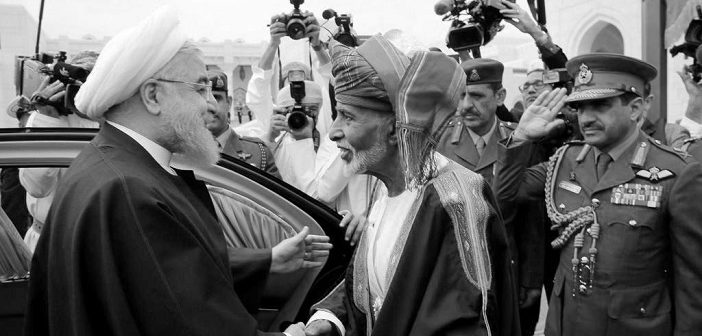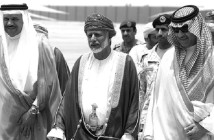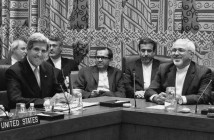From “middle-man” to “no man’s land”… Most analysis about Oman seems obliged to begin with justifications of why the small Gulf Cooperation Council (GCC) state matters, which in itself shows the extent to which the Sultanate goes under the radar. For Omanis this has been just fine.
The only international attention Oman really wants is from tourists entering their new state-of-the-art airport, investors looking for lucrative (and relatively stable) opportunities, and international approval for its active neutrality and diplomatic mediating role. For the last four decades Oman has been “the useful and benign middle man” in many Gulf and wider Arab disputes.
This neutral mediating function is reflected in clichéd analogies by analysts of Oman’s foreign policy, variously referring to the “Central Sultanate”, “Oman in the Middle” and “Omani balancing” amongst many others. The primary benefit of this reputation has been to keep the modestly resourced sultanate out of harm’s way while it focused on internal development. In 2018 this balancing act is becoming increasingly difficult if not impossible for Oman.
Moreover, the carefully crafted neutral reputation of Oman is being brought into question by regional and international players – especially the U.S. Trump administration, Saudi Arabia and its allies.
* * *
Two main factors have permitted the success of Oman’s regional strategy from the 1970s until recent years. First, sufficient income from oil exports has ensured financial independence and a healthy state budget. Secondly, stable and decisive leadership has been consistent in foreign and domestic affairs. The careful leadership of Sultan Qaboos has unified the geographically and socially diverse country, which has built up strong resistance to any external interference. Both these factors are now uncertain after oil prices plummeted in 2014, casting Oman’s fiscal budget into disarray, and concerns continue over the health of the 77-year-old Sultan Qaboos, who remains the chief architect and talisman of Oman’s so-called “renaissance”.
Oman’s agency and independence in balancing regional and domestic challenges is also diminishing. Internal and external factors are converging, which could put Oman in the headlines for other, less desirable, reasons. Like Belgium and Poland in 1939, Oman is at risk of becoming the “meat” in the middle of larger powers’ geopolitical adventures. If Oman is destabilised, or its independence is compromised, the reasons why Oman has mattered could become immediately obvious: consider the implications, for instance, if the Straits of Hormuz closed or became a zone of military contestation; the Yemen conflict and/or its humanitarian effects spilled across GCC borders; Iran and Saudi Arabia moved towards direct conventional warfare; or if intra-GCC ruptures proved permanent, allowing external actors (outside of the traditional US-UK security framework) such as Turkey, Iran, Russia and China to initiate or expand strategic influence, which could fatally fragment Gulf unity and cancel any economic or political benefits from future Gulf Arab integration. Oman has in various diplomatic and geostrategic ways been pivotal in preventing most of these outcomes to date – although it should be noted that Oman did vote against the Saudi-led Gulf Union initiative in 2012, seeing it not as a step towards constructive integration but a vehicle for Saudi hegemony.
Ongoing tensions and conflicts in the wider Middle East have strained Oman’s efforts to straddle sides which are interminably drifting apart. The main challenge is the Saudi-Iranian regional competition and their support to opposing sides in Yemen and Syria, as well as Lebanon. However, it has been the intra-GCC diplomatic crisis between Saudi Arabia and Qatar, starting June 2017, which has placed the greatest strain on Oman’s ‘middle-man’ role. A year later, the blockade enforced on Qatar by Saudi Arabia, United Arab Emirates (UAE), Bahrain and Egypt has failed to bring Doha to heel under Riyadh’s suzerainty. In response, on June 5th, 2018, Saudi Arabia and the UAE signed a bilateral agreement called “Strategy of Resolve”, which leaves out the other Gulf partners and essentially creates a quasi-military, economic and political union between these two giant Arab economies in a move which seems likely to be the death knell of a fully functioning GCC. In a further symbolic step, Saudi Arabia has sought tenders for constructing a waterway separating Qatar from the Arabian Peninsula. Essentially, having failed to tame Qatar, Saudi Arabia is looking to set Qatar adrift from the GCC.
For Oman – and also to an extent, Kuwait – this new political landscape puts them in a quandary. Oman needs to be part of a functioning and well-integrated GCC, especially now that the sultanate’s financial position is dire. Since the collapse of global oil prices in 2014, Oman’s international credit ratings (despite recent recoveries in oil prices) have sunk to ‘junk’ status with Standard & Poor and are only slightly better with Fitch & Moody. Domestically, Oman faces serious challenges making ends meet in its state budget, including meeting a hefty public-sector wage bill, let alone finding new employment for swathes of young graduating nationals.
In addition, Donald Trump’s decision to withdraw from the Iranian-Obama (P5+1) nuclear deal has put a major spanner in the works for Muscat, who expected to reap a strong dividend in Iranian and U.S. economic and political goodwill for its role in facilitating large parts of the deal. More importantly, Muscat hoped that the nuclear deal would lead to a long-term rapprochement between Iran and the GCC states, which would lock-in Oman as the “keystone” of trans-Gulf economic and political affairs. The fact that the U.S. has seemingly put itself firmly in the Saudi-Emirati (and Egyptian) corner and resumed hostility towards Iran has shattered Omani hopes in this regard. The repositioning of the U.S. vis-à-vis Iran was clear with the replacement of Rex Tillerson as Secretary of State with anti-Iran “hawk” Mike Pompeo in late-March 2018. The shift in U.S. Gulf policy was likely conveyed directly to Oman’s Sultan Qaboos by U.S. Secretary of Defense General Mattis, who met with Sultan Qaboos in Muscat at the same time Tillerson was being deposed.
The upside for Oman has been a tremendous increase in trade relations with Qatar as a result of the 2017-18 Saudi-led blockade. Oman’s non-oil exports to Qatar skyrocketed 144 per cent in 2017 and Oman became Qatar’s largest non-oil export market during the blockade. Moreover, Oman Air (the sultanate’s national carrier) has taken advantage of Oman’s neutrality compared to Qatari and Emirati competitors to increase its business around the Gulf. The downside, however, of this desperately needed economic windfall is that it has irritated Oman’s northern neighbours considerably. Most importantly, perhaps is the damage it has done to Oman’s reputation for absolute neutrality in regional affairs. In Saudi Arabia and the UAE’s eyes Oman is moving closer to both Iran and their Al-Houthi allies, and Qatar and their Turkish allies. For Saudi Arabia the spectre of the Muslim Brotherhood also looms even larger following the stunning (albeit contested) victory of Recip Tayyip Erdogan, as the first executive president of Turkey in late June 2018.
The Yemen conflict continues to provide serious security concerns for Oman. In late June 2018, an Emirati-led assault on the western Yemen port city of Hodeidah was launched. This attack on the Al-Houthis last major coastal stronghold and bridgehead to the outside world, not only puts the city’s 700,000 residents at risk but also threatens the flow of crucial aid assistance to the millions of Yemenis who are trapped in the conflict (47 percent of food imports arrived via the port in the first months of 2018). The Emiratis announced that they were activating a longstanding plan to liberate the port, free it from Al-Houthi “extortion”, then widely expand aid deliveries across Yemen. Arguably, neither side will prioritize humanitarian concerns in the battle to control the strategic seaport. Either way, the potential for a massive escalation of the humanitarian crisis across Yemen will place added pressure on the Omani-Yemeni border.
Since 2015, Oman has tried to play its customary neutral, mediating role in Yemen. Whilst declining to accept Yemeni refugees, Oman has worked hard to provide humanitarian and medical assistance to Yemeni civilians, for example, flying badly wounded individuals to Muscat hospitals for treatment. However, recent accusations by the Saudi-Emirati bloc, and the U.S. (General Mattis raised the issue with Sultan Qaboos in the above-mentioned March 2018 meeting) of Iranian arms flowing through Omani land and sea space to Al Houthi rebels – whether accurate or not – has further sullied Oman’s reputation. In fact, the Trump administration has signalled its stance by indicating that Muscat must do more to stem the flow of weapons into Yemen, if it hopes to continue to play a major role in future peace negotiations. Whether or not Oman can fully guarantee the non porosity of its land and sea borders with Yemen is another question, as Oman has long relied on the collaboration of the Al-Mahri tribes who straddle the Oman-Yemen border. Omani government largesse to the border tribes has led to their personal loyalty to Sultan Qaboos, which has been a major factor in shoring up Oman’s border security. However, with Oman’s economic woes and a possible transition in the near future from Sultan Qaboos, the future effectiveness of Muscat-Al-Mahri relations comes into question. In all, Oman’s hard-won status as an objective arbiter in the Yemen crisis is in peril as it tries to prove its sincerity to all sides including the main external and internal antagonists.
At the other end of the country Oman also faces geopolitical tensions that severely test the Sultanate’s neutrality. Simmering unease has existed between Abu Dhabi and Muscat since an Emirati spy cell was uncovered in Oman in 2011. Then in November 2017 a map of the UAE was unveiled at the high-profile opening of the Abu Dhabi Louvre showing the Omani governorate of Musandam (the strategic area, which flanks the Straits of Hormuz) as part of the UAE. It should be noted the map also made Qatar disappear completely. The political symbolism was highly provocative and Sultan Qaboos was said to be furious, with unconfirmed rumours circulating that Omani troops were placed on alert. In this context the state visit of Egypt’s president Abdul Fatah El-Sisi to Muscat on February 4th, 2018was rumoured to be partly aimed at cooling tensions between Abu Dhabi and Muscat. Similarly, to the Al-Mahri tribes in the southern border zone, Muscat has long provided additional privileges to Musandam residents to ward off Emirati overtures. For example, job seeker allowances, which were initiated after 2011 protests in Oman, were eventually cancelled everywhere except in Musandam. In another signal of the Omani government’s extreme sensitivity to the Musandam issue, directives were sent out to government agencies, schools and universities, that only official Ministry of Defence maps of Oman were to be used to depict Oman and its borders.
Oman’s economy has stood up relatively well considering the challenges it has faced since 2014. Around Muscat, new businesses and developments continue to spring up and the shopping malls remain full of Omani and expatriate consumers. How sustainable the economy is remains the main question, however, as the government, wary of social unrest, continues to absorb much of the financial impact of budget shortfalls. In April 2018, the IMF concluded a visit to Oman with a strong message that rapid structural reform was urgently needed to address Oman’s ailing economy. However, as recent events in Jordan have shown, economic shock therapy may be the wrong medicine for Oman at this time. Large scale rapid subsidy cuts and public-sector restructuring could bring internal instability and potential disunity at a time when regional actors seek to intervene in Oman. Rather, ways need to be explored how to carefully calibrate gradual economic and political reform, which maintains Oman’s internal cohesion whilst creating realistic opportunities to the waves of educated and politically aware young Omanis leaving schools and universities.
* * *
In the Gulf geopolitical power game Oman has long played the role of middle-man; however, now it enters an uncertain no-man’s land as the Saudis and Emiratis can simply wait for Oman’s economic and political succession uncertainties to manifest into opportunities to bring the sultanate under their suzerainty in similar fashion to Bahrain. Likewise, Iran stands ready to embrace Oman into its regional expansion plans as the sultanate backs away from Saudi-Emirati pressure to cede to their demands (as was the case for Qatar, who normalisedrelations with Iran in August 2017).
Either way, the skilful balancing act that saw Oman assume a reputation for neutrality and constructive diplomacy while the country focused on internal development will be sorely tested in the latter half of 2018 and beyond.






2 Comments
Oman tries to be the Switzerland of the Middle East but without the banking arguments against Saudis Swiss did have in 1939 against Germany. This situation is then dangerous for Oman for the short run …but on the long run, Oman seems to have done the right choice. After all, Qatar, Kuwait, Iran, Iraq, Syria, Lebanon and maybe Yemen after the end of the Hudaidah battle and even Turkey, all more or less behind China and Russia, are looking more stable than Saudia, UAE, Hadi Yemen, Jordan, Israel, Egypt, EU, Trumpland, US Deep State, etc.
Pingback: ORPIC: Integrated Management Plan - columbiapapers